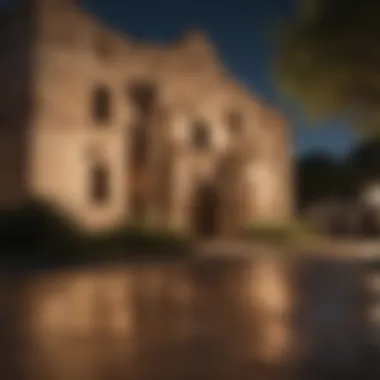Discovering San Antonio's Unique Neighborhoods


Intro
San Antonio is rich in history and culture, offering diverse neighborhoods that each possess their own unique charm. For homeowners, investors, and travelers, understanding these areas is essential to appreciate the vibrancy of this Texan city. This article aims to navigate through notable neighborhoods, focusing on architectural designs, historical significance, and community resources. By exploring these elements, readers can gain a deeper understanding of what makes San Antonio appealing.
Exquisite Architectural Designs
San Antonio showcases a variety of architectural styles that reflect its diverse history and cultural influences. From Spanish colonial to modern styles, each neighborhood exhibits its own personality through its buildings. The attention to detail in these structures often tells the story of the area's past.
Unique Home Features
In neighborhoods like Alamo Heights and Stone Oak, one can find beautiful homes characterized by elaborate tile work, stucco walls, and wrought iron details. Many residences incorporate large verandas and spacious courtyards, allowing for outdoor living, which is popular in the Texas climate. Spanish-style homes often emerge here, blending traditional aesthetics with modern comforts.
Historical Significance
Many of the homes in these neighborhoods have historical value. For instance, the King William Historic District features Victorian mansions that date back to the late 19th century. These homes reflect the economic boom fueled by local industries of that era, leaving a rich architectural legacy.
"The neighborhoods of San Antonio serve as a canvas of its historical and cultural narratives, each painting a unique picture of the city’s growth and transformation."
Community Resources
Each neighborhood in San Antonio offers various community resources that can enhance the living experience. Parks, schools, and local businesses contribute to the overall attractiveness of an area. Access to quality education through esteemed institutions like the University of Texas at San Antonio enriches neighborhoods, making them suitable for families and young professionals alike.
Local Amenities
Homeowners often look for accessibility to shopping and recreational areas. Neighborhoods such as The Pearl District and Downtown San Antonio provide a blend of commercial and entertainment options, including restaurants, boutiques, and cultural venues.
Transportation Accessibility
San Antonio’s network of public transportation, including buses and the VIA Metropolitan Transit, ensures that residents have safe and convenient options for commuting. This accessibility is a vital factor in choosing neighborhoods, particularly for those who work in or near downtown.
Epilogue
This exploration of San Antonio's neighborhoods reveals a complex tapestry of architectural beauty, historical importance, and vibrant community life. Understanding the distinct features of each area can greatly benefit anyone looking to invest or relocate. As you contemplate your options, consider not just the properties but the rich cultural environment that each neighborhood offers.
Prelude to San Antonio
San Antonio stands as one of the most vibrant and engaging cities in Texas. Understanding its core attributes is essential for anyone interested in its neighborhoods. This city is a blend of rich history, diverse culture, and contemporary living, drawing both residents and visitors alike. The introduction sets a foundation for deeper exploration into what makes San Antonio unique. By grasping the essence of the city, readers can better appreciate the neighborhoods that shape its character.
Overview of the City
San Antonio is the second-most populous city in Texas. It is known for its sprawling landscape, warm climate, and a mix of urban and suburban lifestyles. The River Walk, an expansive network of paths along the San Antonio River, serves as a significant center of social activity. This area is lined with shops, restaurants, and other attractions, making it a focal point for both residents and tourists. The economy is diverse, with key sectors including healthcare, military, and tourism. This urban setting boasts a unique charm, appealing to various demographics, from young professionals to retirees.
Historical Context
The history of San Antonio is rich and diverse. Founded in the early 18th century, the city was established by Spanish settlers, with significant contributions by Native American tribes, particularly the Payaya. The site of the Alamo attracts millions each year, highlighting the city’s importance in Texas history. The Battle of the Alamo, fought in 1836, was pivotal in the state's quest for independence from Mexico. This historical backdrop influences the city's identity today.
A blend of Spanish and Mexican heritage is evident in the architecture, food, and community celebrations. Many neighborhoods retain elements of this historical charm, making San Antonio a living museum. The city’s history is not just in museums but is felt in the spirit of its residents and their traditions.
Cultural Significance
Culturally, San Antonio is a melting pot. The influence of Mexican culture is prominent, evident in its festivals, cuisine, and art. Events like Fiesta San Antonio celebrate this heritage, drawing large crowds annually. Moreover, the city is home to various art institutions, including the San Antonio Museum of Art and the McNay Art Museum. These places showcase both local and global artistic expressions.
The music scene is lively, with many venues offering genres ranging from Tejano to jazz. For those interested in culinary arts, San Antonio is noteworthy for its fusion of flavors, offering everything from traditional Mexican fare to innovative new cuisine.
In sum, San Antonio's cultural tapestry greatly enriches its neighborhoods, making them unique places to live and visit. Understanding this context serves as a vital step for anyone looking into the best areas to explore or reside in this dynamic city.


Key Neighborhoods in San Antonio
The neighborhoods within San Antonio are more than just geographical delineations; they represent the city's character and lifestyle. Exploring the key neighborhoods offers insights into diverse living options and property values. Each area contributes to the rich tapestry of San Antonio, balancing history, culture, and modern amenities. This section delves into significant neighborhoods, uncovering their uniqueness and the appeal they hold for potential residents and investors alike.
Alamo Heights
Historical Background
Alamo Heights boasts a long history that dates back to the early 1900s. Originally developed as an upscale suburb, it has maintained its heritage through preservation efforts. The area is known for its affluent residents and a tight-knit community. The historical significance of Alamo Heights is apparent in its well-maintained landmarks and the vibrancy of local culture, making it a desirable location for families and professionals.
Architectural Styles
The architectural landscape of Alamo Heights is diverse. Home styles range from Mediterranean Revival to Contemporary. Historic homes are often distinguished by their elegant facades and well-manicured lawns. This variety appeals to buyers seeking character and charm in their living spaces. While older homes may require updates, they often provide a unique story and substantial value to the neighborhood.
Local Amenities
Alamo Heights provides a wealth of local amenities. With parks, shops, and dining options, it caters to both leisure and everyday needs. The proximity to cultural institutions further enhances its appeal. Residents enjoy a balanced lifestyle where convenience meets community spirit. However, the upscale nature of these amenities can lead to higher living costs, which some may consider a drawback.
The Dominion
Overview and Development
The Dominion is a sought-after upscale community in San Antonio. Known for its upscale developments and exclusivity, it presents a blend of luxury living and privacy. It has evolved into one of the most prestigious neighborhoods, featuring gated communities and a robust security presence. Investors are attracted to its potential for appreciation due to its desirable location.
Luxury Living
Residents of The Dominion experience luxury living at its finest. Properties range from sprawling estates to modern villas with state-of-the-art amenities. This level of luxury is a significant draw for high-net-worth individuals. However, such opulence comes with higher costs, which may limit accessibility for an average homeowner.
Sporting and Recreational Facilities
The area boasts various sporting and recreational facilities. Golf courses, tennis clubs, and fitness centers are commonplace. These amenities cater to an active lifestyle and promote community engagement. While this encourages a healthy living environment, the emphasis on luxury sports facilities can make it less appealing for those seeking lower-cost recreational options.
Stone Oak
Residential Dynamics
Stone Oak is a growing community that attracts families and young professionals alike. The demographics show a mix of age groups, ensuring a vibrant community. This neighborhood has seen rapid development, with new homes and commercial areas emerging to meet demand. It represents a balanced lifestyle with a focus on family-friendly environments and community-oriented activities.
Educational Institutions
Stone Oak is recognized for its quality educational institutions, including public and private schools. Families often choose this area for its strong academic reputation. The presence of these institutions enhances property values, making it desirable for buyers focusing on education. However, competition for spots in certain schools can be intense, presenting challenges for new residents.
Commercial Hub
The commercial landscape in Stone Oak is robust, featuring retail centers, restaurants, and essential services. This accessibility provides convenience for residents and contributes to a vibrant local economy. While this makes everyday living easier, rapid commercial growth can create traffic issues, potentially impacting the neighborhood’s peaceful atmosphere.
Downtown San Antonio
Historic Districts
Downtown San Antonio is rich in historic districts, each with its own character. From the cobblestone streets to the beautifully restored buildings, history is evident everywhere. This unique blend of past and present attracts various visitors and residents. Living in a historic district offers a sense of charm, but it often comes with stricter regulations regarding property modifications.
Cultural Institutions
The cultural landscape in downtown is vibrant, boasting museums, theaters, and art galleries. These institutions serve as a cultural hub, promoting art and education within the community. This expansiveness attracts both residents and tourists, enhancing the overall appeal of downtown living. However, the density of visitors can sometimes lead to overcrowding, hindering the local experience.


Nightlife and Dining
Downtown San Antonio offers a dynamic nightlife and diverse dining options. From upscale restaurants to cozy cafes, culinary choices abound. This variety fosters a lively atmosphere and enhances community interaction. While many embrace the lively nightlife, some residents may find noise and crowds a disadvantage during peak hours.
King William District
Victorian Architecture
The King William District is known for its stunning Victorian architecture. Many homes date back to the late 19th century, offering intricate designs and craftsmanship. This aesthetic charm appeals to those who appreciate historical beauty. Properties here often require considerable upkeep, which can be a challenge for new homeowners.
Art and Culture
This district is a hub for art and culture, with local galleries and cultural events that contribute to a rich community spirit. Artists and creators are drawn to its inspiring atmosphere. However, gentrification has changed some aspects of the community, which may be a concern for long-time residents.
Community Events
King William has a strong focus on community events, often hosting festivals and art walks. These events foster a sense of belonging. They showcase local talent and bring neighbors together. While engaging, these gatherings can also lead to increased traffic and noise.
Southtown
Art Scene
Southtown is a vibrant area celebrated for its flourishing art scene. Local artists showcase their work, enhancing the neighborhood's creative vibe. Galleries, studios, and art events are common, attracting many visitors. However, some residents may feel that this artistic activity disrupts the peace of the neighborhood.
Dining Experiences
This area also offers a plethora of dining experiences, from casual to gourmet. Restaurants often source local ingredients, contributing to its unique culinary identity. This focus on dining enriches community life. Still, the popularity of these venues can lead to long wait times during peak hours, which can be inconvenient.
Historic Significance
Southtown is steeped in history, with many buildings reflecting its past. The preservation of these historical sites adds to its charm, attracting those interested in heritage. Maintaining these buildings can be costly, presenting challenges for property owners who wish to retain authentic styles and characteristics.
Weston Centre
Business Development
Weston Centre is a pivotal area for business development in San Antonio. It serves as a commercial hub, housing offices, and businesses ranging from startups to established companies. The area's growth reflects the city's economic vitality. However, this development may lead to fluctuating property values, posing a risk for investors.
Residential Options
While primarily commercial, Weston Centre also offers residential options. Apartments and condos provide modern living spaces with easy access to workplaces. This convenience attracts young professionals seeking urban living. Nevertheless, higher rental prices can be a barrier for some, limiting long-term residents.
Commercial Spaces
The availability of commercial spaces in Weston Centre supports a thriving local economy. Shops and services cater to both residents and workers, making it a bustling area. This mix of commerce promotes a vibrant lifestyle but can also create challenges such as traffic congestion.
"Each neighborhood in San Antonio presents its own distinct characteristics. Understanding these traits can help potential buyers and renters make informed decisions about where to live."
In summary, San Antonio's neighborhoods offer a variety of choices that cater to different preferences and lifestyles. From the historic charm of Alamo Heights to the modern conveniences in Weston Centre, each area contributes to the overall allure of the city.
Real Estate Trends in San Antonio
Understanding real estate trends in San Antonio is essential for those looking to buy, sell, or invest in property within this vibrant city. The housing market provides indicators of economic health, community resources, and overall quality of life in various neighborhoods. By examining these trends, stakeholders can make informed decisions that align with their goals.
Market Overview


The San Antonio real estate market presents a dynamic landscape characterized by steady growth and diverse offerings. According to recent data, the city has experienced a surge in demand for residential properties, driven by population growth and an influx of businesses. This increase in demand has led to a competitive environment where bidding wars are not uncommon.
Affordability remains a key point of interest. Compared to larger cities like Austin and Dallas, San Antonio offers relatively lower home prices. The average home price in San Antonio sits around $300,000, making it attractive for first-time buyers and investors alike.
Moreover, the city is seeing a rise in construction activities to accommodate the growing population. New housing developments are sprouting in suburbs, reflecting a trend of urban migration.
Rising Neighborhoods
Several neighborhoods in San Antonio are becoming hotspots for real estate investment. Notable areas include:
- Southtown: Known for its artistic atmosphere, this neighborhood draws many young professionals and families.
- Stone Oak: Offers a suburban feel with excellent schools, making it popular among families.
- Alamo Ranch: This area has seen significant growth, with more amenities being developed, appealing to new homebuyers.
Each of these neighborhoods offers unique facets that cater to different lifestyles, showing great potential for appreciation in property value.
Property Values and Trends
When analyzing property values in San Antonio, a few key trends emerge. Over recent years, there has been a consistent uptick in home values, indicating a healthy and thriving market. For instance, homes in neighborhoods like The Dominion have appreciated significantly, reflecting their desirability.
Additionally, supply and demand play a crucial role. While new builds are on the rise, the limited inventory in sought-after areas maintains upward pressure on prices. Notably, homes that are well-maintained and located in good school districts often attract higher prices and quicker sales.
As a prospective buyer or investor, it is vital to stay aware of these trends. Emerging data can guide decisions about where to purchase and for what price. By being informed, one can capitalize on opportunities as the market continues to evolve.
"Understanding the nuances of the San Antonio real estate market is essential for making sound investment decisions."
Overall, the San Antonio real estate market reflects a blend of tradition and modernization. Home buyers and investors looking to enter this market can benefit from recognizing these trends to make informed choices.
Community Resources
Understanding the community resources in San Antonio is essential for potential homeowners and real estate enthusiasts. These resources can greatly affect the liveability of neighborhoods. They encompass educational institutions, healthcare facilities, and parks and recreational areas. Each component contributes to an area's appeal and overall quality of life, making it necessary to dive into these topics.
Educational Institutions
Educational institutions are a cornerstone of any community. In San Antonio, there is a diverse range of schools and colleges. The presence of well-rated public schools can attract families looking for a new home. For example, North East Independent School District serves a large portion of the city and is known for its strong academic performance.
In addition to primary and secondary education, the city boasts higher education institutions such as the University of Texas at San Antonio and Texas A&M University-San Antonio. These universities contribute to the local economy, provide a skilled workforce, and enhance the cultural richness of the area. When evaluating neighborhoods, consider the proximity of these institutions, as it influences property values and rental demand.
Healthcare Facilities
Access to healthcare facilities is another critical aspect that potential residents should consider. San Antonio is home to numerous hospitals and clinics, ensuring residents receive quality medical care. Major hospitals like University Hospital and Methodist Hospital are recognized for their specialized services and care.
An abundance of local clinics and urgent care facilities make it easier for families to seek medical attention without needing to travel far. Moreover, the presence of healthcare facilities can impact home values when considered by buyers focused on community health. Thus, neighborhoods backed by robust healthcare services are often more desirable.
Parks and Recreational Areas
Parks and recreational areas play a significant role in community wellbeing. The city is rich in green spaces, from sprawling parks like Brackenridge Park to smaller neighborhood playgrounds. These spaces encourage outdoor activities and foster social interactions among residents.
The availability of walking trails, sports facilities, and picnic areas enhances the quality of life, making neighborhoods more attractive. For instance, the San Antonio River Walk not only offers a scenic area for walks but also hosts regular events that engage the community. Such amenities are attractive to homebuyers who prioritize an active lifestyle.
In summary, community resources greatly shape the fabric of neighborhoods. The educational institutions, healthcare facilities, and parks serve as essential pillars supporting community growth and quality of living. Homebuyers should weigh these factors carefully when exploring San Antonio's diverse neighborhoods.
Finale
The exploration of San Antonio's neighborhoods reveals the intricate tapestry of history, culture, and lifestyle that defines the city. Each area offers unique characteristics that cater to diverse preferences and needs. Understanding these aspects is crucial for homeowners, real estate enthusiasts, and potential movers alike. The neighborhoods discussed provide not just housing but also a sense of community, rich cultural experiences, and access to essential resources.
Summary of Insights
In summary, San Antonio's key neighborhoods showcase a variety of living options that appeal to different demographics. Alamo Heights boasts historical elegance, while The Dominion presents luxury living. Stone Oak stands out for its family-friendly environment, whereas Downtown San Antonio offers urban vibrancy. The King William District brings history to life through its architecture, whereas Southtown thrives on its art scene. Each area contributes to San Antonio's comprehensive map of lifestyle choices.
> "An informed decision about where to live is not only about the property itself but also about the community and amenities surrounding it."
Future Perspectives
Looking ahead, San Antonio's neighborhoods are likely to continue evolving. Urban development will shape these areas, enhancing infrastructure and amenities. The demand for housing will rise, leading to potential increases in property values. Investors and homeowners should keep an eye on emerging neighborhoods. As the city grows, so too does the opportunity for unique residential experiences.















